#C: Lamium
Text

Happy to have this beautiful dead nettle ( Lamium purpureum ) !!
The essential oil obtained from the plant is characterized by a high content of germacrene D. The oil obtained from the seeds of the red dead nettle contains lamenalenic acid. The plant also contains phenylethanoid glycosides lamiosides A, B, C, D and E and flavonol 3-O-glucoside-6 "-O-malonyl transferase, quercetin, vitamin C. 🌿🌿🌿
#witch garden#witchlife#healing#dead nettle#goodvibes#helth benefits#helth tips#garden#beautiful#good energy#for the future
6 notes
·
View notes
Text
Hippophae twig.
One recipe am share , which shared herbalist to me.
When my family visited at home after baby birth, in baby found staphylococcus, all our family shocked, by friend advice visited herbalist, and she has given recipe. Twigs of hippophae are cure effects having all year, and for this recipe need are one-year twigs, and for baby 5 cm of one year twigs, adding in hot water, close lid and infuse 40 min, give for baby one tea.sp. every hour within two days and on the nighttime . This recipe helped and for women and for my grandson, doses and increasing by feeling, this a not chemistry, without side effects.And in other grandson appendix broken, surgery done, after hospital at home temperature raised, he used hippophae infusion for three days and all faster normalized.
On my 40 y.old am reading zoz for 20 years, my grandmother received his, and when she is dead am kept a friendship with zoz. Am a veterinary, and for a curing village animals, as joints, burns, skin, udder in cow am using ointment, which am too using for itself. Lots of peoples ,who are having animals as pigs, cows, horses are happy and thanked to me. And peoples too used this ointment, which am self came out. Melting 100 gr any nutrition fat as of goats, lard, or goose , adding 100 ml. vegetable oil, lead mass till boiling and add in her one tbl.sp. dried fl. chamomile, calendula, herb yarrow and plantain. Stew 3 hours is on the water bath, cool till 70 degrees, filter through a few gauze layers, press, add in clean jar of glass, keep in dark, cool, place.And use As for skin damages and edemas for joints.
And on the last time am found, that lots of males having adenoma prostate, our Chuvash herbalists are created mixture of 14 herbs,with entering leafs of hazelnut, birch, blueberry, comarum palustre , flowers blue cornflower, golden rod, herniaria, clover white, toadflax, mellilotus yellow, onion arrow, berries juniperus, lamium album, south herb kidney tea.
15 gr of every herb chop his, mix, and one tbl.sp. mass add in 0.5 l. for the hot water, boil ten min on weak fire, use one glass as 70 ml for 3 times/day before meal. Cool remedy in refrigerator, and by patients share, this remedy works good and helped.
And where is liver having am never knew, till 50 years, and till she stayed worried me. Course for supporting therapy am used and diet, and am also can use herbs. And am used in all recipes, but onion jam for me helps good in lever inflamer. One kg onion chop, mix , add two glasses sugar, and out in warmed oven till 150 C, and keep in oven till forming yellow syrup. And this syrup you need to use every day and one tbl.sp. on an empty stomach within a few months.
And in a few years later am feeling a good, and not remembering about this cure.
On my 60 y.old doctor shared to me, that cataracts beginning, and not shared advices. Am never heard about this am not a medical person, but true interested, and read about honey drops, and am a beekeeper of 3-5 families, thus am cooked honey drops.
As later am knew more about bees and bee products, am rationalized recipe, honey used just spring. Am prepared his from the spring blooming herbs, and taken jar, found a fresh spring ripe honey, and on displaying mother liquor, am prepared royal jelly milk, and canned by this honey, and of this honey with royal jelly milk and distilled water am prepared my drops. Royal jelly milk take from mother liquor not later 15 hours from removing mother liquor, canning as one to 100 as one tea.sp. of royal jelly milk for 100 gr honey.Drops cook for 1 to 3, as part of honey and 3 parts distilled water, keep in refrigerator. Avoid cook a much, just cook of a few days, so as drops staying sour. Drip in eyes for one time in the evening.
And not on my 92 y.old am reading, writing without glasses, and on 2018 my bees are poisoned, am lost my drops, without two my vision worsened, but am not give up, am sure these drops are not just helping in cataract, thus am share my recipe in zoz with you, maybe for you too helps.
from Valga s health news,gardening,and cooking ,and beauty . https://ift.tt/Isn7dpr
via https://ift.tt/WNvytRm
0 notes
Photo

Carnelian comes again.
He is not as he once was. Once, he smelled of cindermint and tobacco smoke, fresh and fiery. Of scented oils carrying the essence of the black cedars where the Susurrant One lurked and whispered. Now he smells of wind and dust and ash and sea salt, and conspicuously not of the Summerlands. Or of his home on the borderland where the mixing of light and shadow magic created a scent like dawn and twilight mingling into a nameless time that Hitth knew only existed there.
He had drifted away from clan and friend, hunting for what Hitth neither knew nor cared. He smelled of travel now, some peace sought in the south and central lands. But he always returns to the Hewn City. The imperial is tough, and perhaps Hitth will open it's facets to him many times. But it is patient.
Carnelian is as addicted to the knowledge of the living Ismene as he was to the liqour that he drowned the knowledge of her death with for three long eons.
When he appears before Hitth, there is no formality or any exchange of words. Hitth spreads it's wings, and the light is all that reflects in Carnelian's unblinking stare.
This is the eleventh time.
The skydancer is nervous, and Hitth struggles to withhold itself.
Estevao is a coward, and cowards are easy prey. He desires so strongly the version of his life he sees in the facets, yet he cannot bear to look at it more than a few seconds. It is true that all anyone must do is turn back to their reality and they are free, but Estevao runs back in fear. Perhaps what he sees is too perfect. Perhaps he is just smart enough to know nothing so perfect can be true.
Or perhaps he suspects that if his life is so lush in that world, he must have made a mountain of enemies from those he used and wheedled and placated.
How many did that other Estevao cast aside? Hitth knew. Just as it knew in this one case, the skydancer was right to be afraid.
Hitth is very good at letting its physical form remember things for it. Fear and caution, things to keep itself alive. But the agitation it feels seeing Ilkilides is so alien in its intensity that it feels its eyes ache.
It's voice is the whisper in the eclipse, it does not need the meager throat of a pearlcatcher if it wants to speak with its true voice. Body language was the body's business, Hitth had nothing to express through it that it could not autonomously perform. But the eyes were different. An Outsider's gaze could nearly replicate itself. Hitth remembers keenly the Great Imprisoner's magics blinding it as it raged so many ages ago. Punishment for daring to use one of his children's eyes to express something as profane as an Outsider's hate.
And every time it was on the verge of such a thing, it felt frost burning on already useless corneas. It calmed itself, but smoldered within while Ilkilides warned that a female imperial that shouldn't be taken would come.
That night, Hitth releases its bottled anger. The scream vibrates the Hewn City. Beyond hearing, yet impossible to drown out. And vile.
The things that slept in the Hewn City stir and thrash that night. Far out in Aphaster, Ranti and Shekhinah ward themselves with powers from ancient ages. Dantalion clutches Heaven in his sleep and gasps so wretchedly that the animancer fears his love is dying in their bed. Tungsten wakes in a hysteria she has never experienced before even when the Tide-prophecy has been so close she has nearly understood its true shape. She is found as a chimera--half-transformed into her true shape to defend herself from something, but too frightened to release the glamour properly. Her shrieks, half human and half guardian and far more awful in their combination than either alone, spread over the Summerlands like an agonized death wail even as the sedative finally frees her from Hitth’s.
What draws them so much more than other breeds, Hitth wonders to itself. Surely, these are the lands of the All-Seeing Locust and they are her firstborn, but none of those who come to Hitth are born to the light. Not Carnelian seeking his daughter, not Ashes who always found the vision right at first but missing something and who would give in easily once he truly saw what he hoped for, not Moksha seeking a world in which he had been raised as safe and pampered as Alief, nor Fadil who mistakenly assumed Hitth a seer who could tell him for truth whether or not he had escaped from the shadow of whatever he had seen in the west.
Kea too was born to something other than the light--to the Calamitous Star in fact.
Inwardly, Hitth grumbles. Ilkilides had warned it that she must return home safely, and had gone so far as to accompany her there. But it loved Arcanites. Craved them to the point of feeling what might have been lust if it were a true dragon. It was their magic, ever reaching out to places it shouldn't, that allowed Hitth and others like it to cross into Sornieth. It was an energy that deserved to be gorged on.
Kea seeks a truth of the present world anyway, though unlike with Fadil, it is a truth Hitth's facets can reveal. The light fills her eyes, and she sees a world where she was present the moment her son was branded by indecipherable runes. She sees the terrible thing writhing with Shekhinah. She sees herself--wounded to protect Lamium. And she sees him screaming his willingness to the sky if it will save her.
When Kea turns her eyes to that same sky, she sees something in the moon. Even though the vision should not have an effect on her, it fills her eyes and she feels as though it knows. And that it is gazing back.
Lamium covers her eyes, and she yelps in surprise.
Hitth starts as the facets go dark. The connection should not be severable by something so simple as breaking eye contact. Yet Lamium's runes glitter bronze and blue on his fingers and Kea is obviously back in the world with them. He is looking at Hitth nervously, backing his mother away though it is obvious he doesn't understand quite why he is wary.
He and Kea exchange words in whispers without going far. She is apologetic for worrying him, but desperate to understand what magics have taken branded him. He kisses her forehead and blesses her for her maternal love and protectiveness, yet warns her firmly.
Had Kea successfully gazed at the Veiled Moon when her shroud was lowered, even from the supposed safety of another time, the imperial would have been harshly punished.
Lamium's gaze at Hitth remains disquieted and mistrustful, but it is Ilkilides he turns his anger on. Whether Hitth is fair or foul a creature, the nocturne led Kea into the Hewn City. For endangering his mother, Lamium curses him:
May you seek Shadows and find only the Shade.
It is a strong curse--one the Hitth is surprised still exists. It calls on troubles from when Hitth was new to Sornieth. A time when Shadow dragons were hunted and hated by the other elements as suspected agents of the Shade, all the while the Shade preyed on them, blending itself into the dark places that should have been safe and secret. It is a curse strong enough that even Ilkilides is shaken to hear it spoken aloud.
Hitth watches Lamium leave with his mother and wonders how a dragon so young and untried could know such an ancient and awful curse.
#Flight Rising#C: Hitth#C: Kea#C: Lamium#C: Carnelian#C: Estevao#C: Tungsten#Voices from the Eclipse
11 notes
·
View notes
Text
10 Reasons to Forage for Purple Dead Nettle
Purple dead nettle, Lamium purpureum, is an edible and medicinal plant that's easy to forage. You may have seen this "weed" and not even known!

1. Purple dead nettle is widespread. This makes foraging pretty easy. It's native to Europe and Asia, but has become common in North American gardens, yards, and disturbed places. It can be a fairly inconspicuous plant, but once you start looking for it I'm almost certain you'll see it growing. It sometimes grows in huge patches, making collecting even easier.
2. Purple dead nettle is easy to identify. It's a member of the mint family and is called "dead nettle" because some think it resembles stinging nettle, minus the sting. I don't really think it looks like true nettles, purple dead nettle has a square stem, fuzzy leaves, and purple tops with small pink flowers. They are low growing, only growing up to ~8 inches tall.
3. Purple dead nettle does not have any toxic look-alikes. It may be confused for henbit, Lamium amplexicaule, which is a close relative and other tasty edible plant. The leaf arrangement is different though, henbit leaves are round and surround the stem while purple dead nettle leaves are triangular.
4. Purple dead nettle is a highly nutritious superfood packed with vitamin C, fiber, and lots of antioxidants. The leaves are edible and the purple tops just a little bit sweet. They make a tasty wild greens pesto and addition to other recipes like soups or salads. Use them any way you'd use other leafy greens or herbs.
5. Purple dead nettle has medicinal benefits. It's known for being astringent, diuretic, diaphoretic, purgative, anti-inflammatory, anti-bacterial, and anti-fungal. The simplest way to enjoy its benefits is to make it into an infusion or tea, either fresh or dried. Keep in mind large amounts of purple dead nettle may have a laxative effect.
6. Purple dead nettle can help heal wounds. It can be used externally on wounds or cuts as a poultice or a salve. Here's 3 ways to make a dead nettle salve.
7. Purple dead nettle can help with seasonal allergies. Stinging nettle is well known and used to help with seasonal allergies, while purple dead nettle is not the same plant it too is recognized by some to help with allergies. A tea or a tincture of purple dead nettle mixed with honey can be used for inflammation and allergies.
8. Purple dead nettle can be fed to chickens. It's a nutritious tasty food for them, along with other weeds like henbit and chickweed. You can chop it up and give it to your chickens as a treat!
9. Purple dead nettle is an important species for bees. Bees seem to prefer it over other plants, even dandelions, and it's one of the first flowers to appear in spring. This makes it a vital bee forage, so always leave lots behind for our buzzing buddies when foraging for ourselves.
10. Purple dead nettle can be used to make a natural dye. If you're a fan of natural dyes for yarn or cloth, purple dead nettle is an excellent choice, it makes a gorgeous soft green color. Here's how.
Learn More: https://www.growforagecookferment.com/foraging-purple-dead-nettle/
#purple dead nettle#foraging#herbalism#medicinal plants#edible plants#edible weeds#eat the weeds#plant medicine#forage
170 notes
·
View notes
Text
Red/Purple Dead-Nettle | Lamium Purpureum
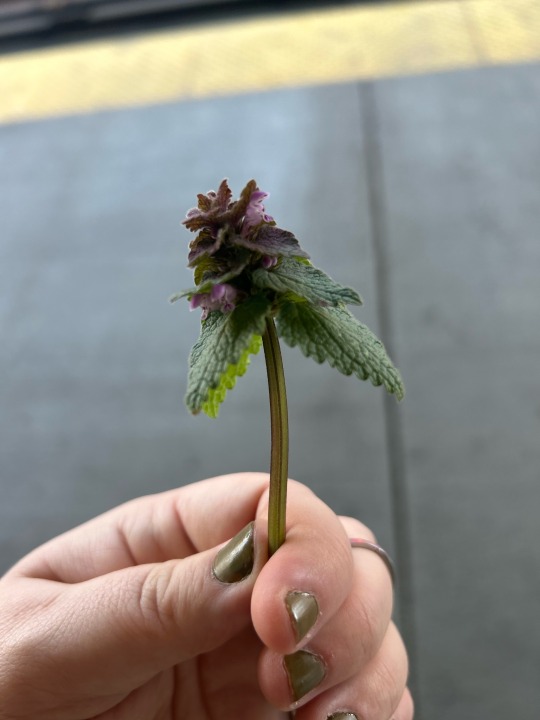
Correspondences : tenacity (due to its tendency to grow and thrive in poor conditions), cheerfulness, happiness, fortitude, willpower
Identified by square stem, fuzzy leaves and purple to green fade from top to bottom.
Practical Uses : encourages the body to perspire and urinate, used to ease painful and heavy periods, works as a laxative in larger amounts,
Magickal Uses : dispels gloom, darkness and fear
Sources:
Dragon, Amber. “Purple Dead-Nettle – No Pain, All Gain.” The Witches' Circle | Aminoapps.com, AminoApps, 17 June 2018, aminoapps.com/c/thewitchescircle/page/blog/purple-dead-nettle-no-pain-all-gain/qm7N_rbHRuBK7lRwqre1BxXeBxpErwrLnj.
Grow Forage Cook Ferment. “Foraging for Purple Dead Nettle: An Edible Backyard Weed.” Grow Forage Cook Ferment, 9 July 2021, www.growforagecookferment.com/foraging-purple-dead-nettle/.
Wigington, Patti. “Magic & Folklore of Purple Dead Nettle.” Learn Religions, Learn Religions, 25 Mar. 2019, www.learnreligions.com/purple-dead-nettle-magic-and-folklore-2562033.
Disclaimer: This post is not professional medical advice. Nothing on this website should be considered as a substitute or replacement for professional medical advice. Persons should seek the advice of qualified health providers.
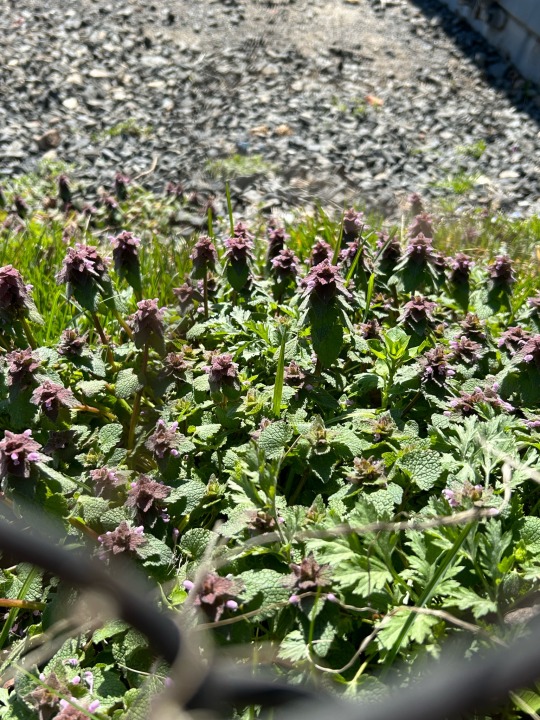
#red dead nettle#purple dead nettle#witchcraft#herbs#magickal herbs#magickal plants#plants#witch#grimoire#witchblr#witch tips
13 notes
·
View notes
Photo

White Dead Nettle (Lamium album) and Common Bugle (Ajuga reptans).
Coloured etching by C. Pierre (circa 1865) after P. Naudin.
Image and text information courtesy Wellcome Collection. Attribution 4.0 International (CC BY 4.0)
70 notes
·
View notes
Text
Identifying Weeds in the Garden
One problem gardeners are constantly struggling with is weeds growing in their flower gardens. A weed is essentially a plant growing where you don’t want it. There are a number of plants that pretty much always fall into the category of weeds, either for thier vigorous growth and ability to take over or the ability to keep regrowing.
Fortunately daylilies are strong vigorous growing plants that compete well with most weeds. That being said, even daylilies can struggle with weeds growing around and even into the clumps.
You're reading: Identifying Weeds in the Garden
Weeds can be divided pretty much into Annuals or Perennials. The management of them is based on this growth habit.
Annuals usually seed in heavily and grow quickly. Killing the young plants and preventing them from going to seed is the best approach.
Perennial weeds on the other hand typically are slow to bloom and seed and start growing a bit more slowly. Regular pulling of the plants is the best approach with attention to removal of all the roots.
Tip: All things being equal, most grasses are weeds, if you focus on the grasses, that will most likely be the majority of your weeds.
On Lawn Management
Our lawns are a hodge-podge of plants including grass (of course), Clovers, Dandelions, Plantain, Violets, Vetches and more.
While on one level we are happy to accept that as that is the easiest and simplest approach, we also enjoy the amazing plant diversity that our lawns exhibit.
Additionally a diverse plant ecosystem (even in a lawn) may result in an planting that is more resilient to adverse conditions like drought, flooding or pest problems.
Here is a list of some of the most common weeds you may find
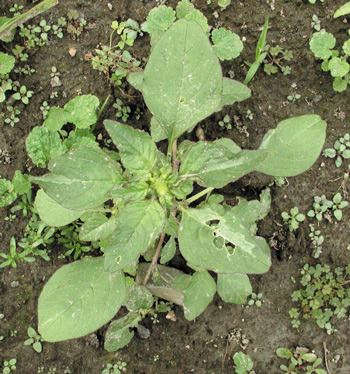
Amaranth: Annual
This is the noxious weed variant of Amaranth
There is a couple of wonderful ornamental types, but this Amaranth is a monster.
Even tiny plants can flower and drop seed. It doesn’t run so that makes it a little easier to control.

Bindweed: (Convolvulus arvensis) Perennial
A member of the Morning glory family (Convolvulacea). Bindweed is a climber, and as such it wraps around and “binds” other plants
It produce small Blue or White trumpet shaped Morning Glory-like blooms
Once established it’s hard to eliminate as it will have wrapped itself all around other plants. Small pieces of roots can re-grow too.
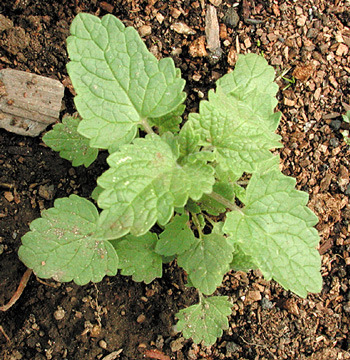
Catnip: (Mentha cataria) Annual
Not really weed per se, but can be a frequent volunteer which can become weed-like in the wrong situation
It is a short lived perennial that reseeds but does not run!
Easily controlled and identified but it’s distinctive smell and square stems (which all mints exhibit)

Chickweed: (Stellaria media) Annual
This weed is very low growing and as such will not really bother Daylilies and Iris much.
It is kind of unsightly running rampantly over open ground. Easy to remove as it
just pulls up nicely. It tolerates cool temperatures well and produces thousands of seeds
early control is important to keep it from spreading via seeds.
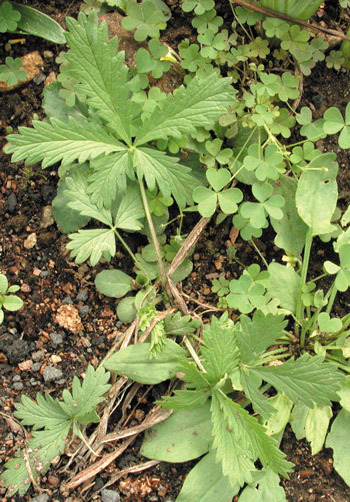
Potentilla or Cinquefoil: perennial
is easily identified by it’s five part leaf. Growing up to 2 feet tall it
Grows from seed and is slow to multiply compared to many weeds. It has a somewhat
attractive yellow flower and as such might be left ialone in the right spot.
Read more: Getting to the Coir of the Matter – FineGardening

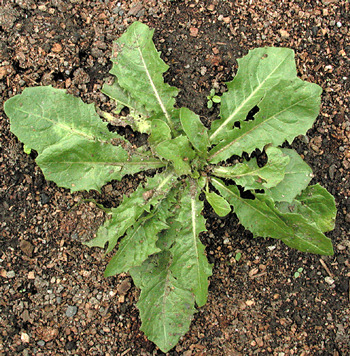
Dandelion (Taraxacum) perennial
is probably the best known weed around. While not particularly invasive, it’s persistence and it’s resilience make it a real problem plant.
Typically if the crown is cut off a new plant will grow. And even flowers that are cut may end up going to seed.
Dandelion does seed in vigorously. The best approach is regular cutting of the crown until the plant wears out (or you do!).
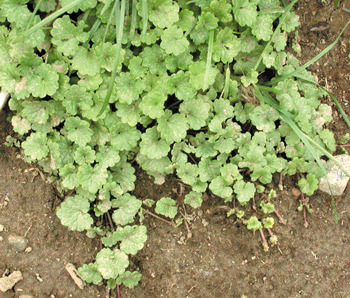
Ground Ivy or Creeping Charlie (Glechoma hederacea) perennial
This plant is easily identified by it’s creeping habit and tiny blue flowers. As it is low it is not a major
competitoor to Daylilies and Iris. however it roots regularly from its growing nodes, so though it’s easy to pull out it can re-root from tiny pieces.
regular pulling and hoeing can help control it.

Horsetail (Equisetum) perennial
Horsetail is a tough weed to eliminate. An ancient relic it is well adapted to survive.
It spreads by runners and seems almost impossible to eliminate without regular removal.
It can grow to 2 feet so it does interfere with the daylilies but not so much that it chokes them out.

Lambsquarters (Chenopdium album): Annual
While definately a weed growing over 5 feet tall, Lambsquarters
also know as Goosefoot and Pigweed is considered by many to be a wonderful food
According to Joan Richardson’s Wild Edible Plants of New England, “Lambsquarters
even outclasses spinach as a storehouse of protein, calcium, phosphorus, iron, vitamin C
, and great amounts of vitamin A, not to mention all the minerals pulled out of the earth
by its strong taproot. It also lacks the puckishness of spinach, although lambsquarters, too, contains oxalic acid.”
It can produce thousands and thousands of seeds so pulling before it blooms and seeds in is crucial!

Lamium (Lamium purpureum) Annual
Dead Nettle as it is called is a low growing, spreading member of the mint family.
Not too competitive with Daylilies and Iris, it will spread in quite vigorously.
the best approach is regular pulling of the plants.

Mugwort (Artemisia vulgaris) Perennial
Mugwort is one of the most pernicious weeds there is! It is a strong spreader that spreads via underground runners.
Tiny pieces of root will regrow and spread quickly. Easily identified by it’s characteristic Marigold smell and silvery undersides, Mugwort is best controlled by constant pulling or ideally smothering with some sort of impermeable material. Grwinf to 3 feet it will grow in amongst your Daylilies and be very hard to eradicate.
Nutsedge (Juncus) Perennial
Nutsedge is another one of those horrible spreading weeds. Growing to 3 feet tall and spreading by tubers, Nutsedge is very difficult to eradicate.
The best approach we have found is to smother it with plastic or some other weed barrier. Easily recognized by it’s 3 sided shape (Sedges have edges)
Pulling will make you feel better but won’t eliminate it.
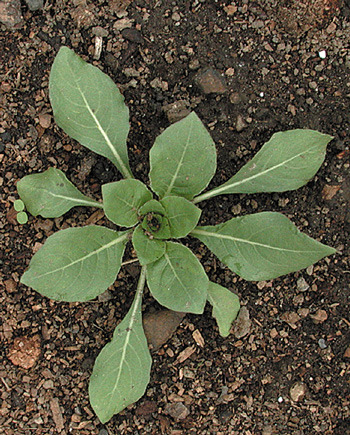
Evening Primrose: (Oenothera biennis) biennial
Evening Primrose is a biennial weed that grows up to 4 feet tall.
Large and imposing it can compete with Daylilies and Iris a bit
but it is not a rampant grower and as such is relatively easy to live with. Cutting it at the crown will kill it too.
It might be worth leaving as it seems to be a Japanese Beetle magnet drawing them away from other plants.

Creeping Sorrel (Oxalis): Perennial
Sorrell is sometimes called Lemon Grass and is a favorite of kids to munch on because of it’s lemony taste.
Small and not too invasive it is easy to pull but seems to pop up everywhere!
Tip: Using smell is a good way to help identify certain weeds/plants. Catnip, Lamium, Mugwort and Mints all have very distinctive smells

Purslane (Portulaca):Annual
While considered a weed, Purslane is not a bad plant, just misunderstood. It only appears in late summer here in Vermont.
Purslane thrives in hot dry conditions. Very low growing, it is never a problem for Daylilies and Iris.
Purslane is considered good eating and very good for you.
From Mother Earth News
“Purslane may be a common plant, but it is uncommonly good for you.
It tops the list of plants high in vitamin E and an essential omega-3
fatty acid called alpha-linolenic acid (ALA). Purslane provides
six times more vitamin E than spinach and seven times more beta carotene
than carrots. It’s also rich in vitamin C, magnesium, riboflavin, potassium and phosphorus.”
Probably just letting it be is the best approach.

Read more: Cat Deterrents for Gardens | Garden Advice – The RSPB
Queen Annes Lace: (Daucus carrota) biennial
Queen Annes Lace is not considered a weed by many. It has wonderful weed airy flowers.
The ancestor of the Carrot, Queen Annes Lace has a deep taproot. Cutting the taproot should control it.
Not too rambunctious we almost always leave Queen Annes Lace be to grow.

Red Clover (Trifolium pratense) perennial
Red Clover is not really a weed. Clovers help add nitrogen to the soil and are excellent bee forage.
But lets face it if it’s growing in the wrong place it’s a weed. Cutting at the crown will control it.
Growing to almost 2 feet tall it could compete with Daylilies and Iris but it is usually not too
overbearing and as such we leave it when we can.

White Clover: (Trifolium pratense) perennial
White Clover is the smaller cousin of Red Clover. We have it in all our lawns and love it!
As a Clover it also adds nitrogen to the soil. Low growing to not compete with Daylilies and Iris we
leave it be most of the time.

Annual Black Eyed Susan: (Rudbeckia annua) annual
Annual Black Eyed Susan is not really a weed either but sometimes it’s in the wrong
place. Easily identified by it’s hairy leaves it starts as a low rosette and then grows to about 2 feet in hieght.
Easily controlled by cutting the crown. In fact trying to transplant it in bloom is a surefire way to kill it!
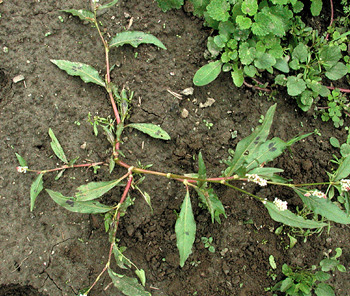
Smartweed; (Polygonum) Annual
Sometimes called Mile A Minute plant! This low growing weed can really spread and seeds in like crazy.
Pulling the plants early and often is the best approach. Thier shallow root system makes them easy to pull.

Velvet Leaf: (Abutilon theophrasti) Annual
Velvet leaf is an invader from from India! Growing up to 5 feet tall.
It’s characteristic velvety leaves make it easy to identify. Persistent and tall we always pull it out
as it will grow taller than the Daylilies and Iris. The seed capsule are fascinating, with a gear like appearance.

Vetch: (Vicia sativa) perennial
Another legume Vetch will also add Nitrogen to the soil. not really a too terrible weed in our experience,
but because it’s a creeper and climber it’s not much fun finding it growing all over your Daylilies and Iris.
Easily pulled from the tops, Vetch will come back but not particularly strongly.
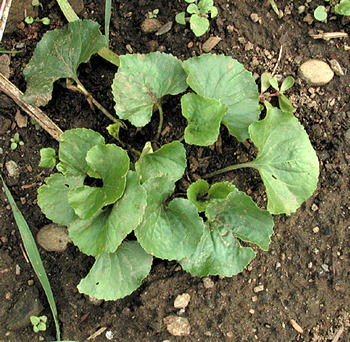
Violet (Viola odorata) Perennial
Definitely not a weed in our opinion, Violets our low growing with wonderful blue-violet or white flowers.
At least when one is assessing ones flower garden, it’s nice to recognize this as a good “weed”
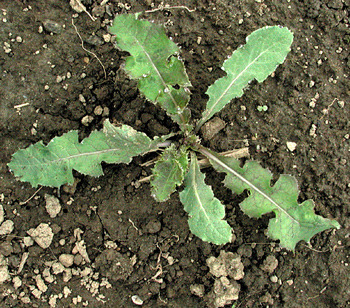
Wild Lettuce: (Lactuca serriola) Annual
Growing to over 5 feet tall, this weed while not particularly invasive is large and imposing.
Cutting the crown before it seeds is the key to easy control.
Quackgrass or Creeping Quackgrass: (Agropyron repens) perennial
We’ve saved the worst for last. Quackgrass is a horrible pernicious weed that runs like crazy.
We have found it growing right through Daylily roots. Constant pulling of the plants and roots is the best control. We’ve found heavily mulched beds make pulling the Quackgrass much easier.
In conclusion:
Nature abhors a vacuum.
Allowing certain low growing weeds to remain can be beneficial as these plants will occupy space and act as a green mulch, helping to prevent certain other less desirable /more invasive weeds from growing.
Source: https://livingcorner.com.au
Category: Garden
source https://livingcorner.com.au/identifying-weeds-in-the-garden/
1 note
·
View note
Text
26 October - 13 November 2020
These past few weeks have been an emotional roller-coaster. Back in September several friends, within 48 hours of each other, informed me about an amazing opportunity in the south of France. I was so touched that people were looking out for me, knowing I’ve been aching to move to somewhere warmer, more Mediterranean. I hesitated for a week because the job announcement on a garden designer’s Facebook page stated French was important. I’ve studied French for a long time and I still have a long way to go to fluency. Again, later in the week, another friend from Kew mentioned it and knew the garden personally.
So I took the plunge and sent my CV, in French, to the garden designers. They liked it well enough to pass it to the client. A week later I had my first phone interview and it went well. Now I was super excited and could hardly sleep. On paper this job sounds really good. I checked out some You Tube videos on the garden designer, their preferred maintenance contractor and the nursery they use. I only became more interested and excited.
Plant ident 30 October
Lamiaceae Salvia africana-lutea syn. of Salvia aurea
Lamiaceae Salvia canariensis
Lamiaceae Salvia confertiflora
Lamiaceae Salvia elegans ‘Honey Melon’
Lamiaceae Salvia greggii x serpyllifolia
Lamiaceae Salvia greggii ‘Stormy Pink’
Lamiaceae Salvia involucrata
Lamiaceae Salvia microphylla var. neurepia ‘Oxford’
Lamiaceae Salvia ‘Nel’
Lamiaceae Salvia ‘Phyllis Fancy’
Plant of the week
Lamiaceae Salvia confertiflora Pohl
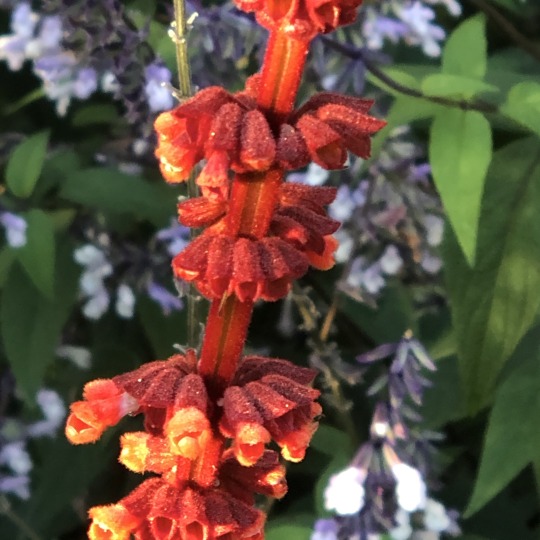
common name(s) - Sabra spike sage
synonym(s) - Salvia confertiflora var. angustifolia J.A.Schmidt; Salvia confertiflora var. brachyantha Pohl; Salvia rufa Epling
conservation rating - none
native to - Brazil
location - salvia walk, accession 2019-0398
leaves - deciduous, pungently-scented, ovate
flowers - slender spikes of small scarlet flowers, covered with velvety red-brown hairs, with the stems of the inflorescence and the calyx also having a red-brown colour, in late summer and autumn
habit - a tender bushy perennial to 1.2m tall, becoming woody at the base
habitat - tropical, summer rains, dry winters
pests - slugs, snails, capsid bug, rosemary beetle, leafhoppers
disease - generally disease-free
hardiness - to 1ºC (H2)
soil - loam, chalk or sand, well-drained
sun - full sun, sheltered
propagation - seed in containers in a cold frame in spring; softwood cuttings in spring or early summer or semi-ripe cuttings in late summer or autumn with bottom heat
pruning - cut down if hit by frost
nomenclature - Lamiaceae - lamium - gullet, the name in Pliny refers to the gaping mouth of the corolla; Salvia - healer, the old Latin name for sage with medicinal properties; confertiflora - with dense or crowded flowers
NB - first discovered in 1833 by the Austrian naturalist, Johann Baptist Emanuel Pohl in the Serra dos Órgãos, state of Rio de Janeiro. Pohl sent specimens back to botanical gardens of Europe where it was popular not only for its dramatic colour, but also for its prolific flowering well up to the time of frost
References, bibliography:
Gledhill, David, (2008) “The Names of Plants”, fourth edition; Cambridge University Press; ISBN: 978-0-52168-553-5
IUCN [online] http://www.iucnredlist.org/search [18 Nov 20]
Plant List, The [online] http://www.theplantlist.org/tpl1.1/record/kew-182420 [18 Nov 20]
Plants of the World [online] http://plantsoftheworldonline.org/taxon/urn:lsid:ipni.org:names:456011-1 [18 Nov 20]
Royal Horticultural Society [online] https://www.rhs.org.uk/Plants/16324/i-Salvia-confertiflora-i/Details [18 Nov 20]
Wikipedia [online] https://en.wikipedia.org/wiki/Salvia_confertiflora [18 Nov 20]
About ten days later I received an email inviting me to meet with his wife, here in London, for a second interview. That took place one evening after work. Again, the conversation went very well and it turns out we have a friend in common - who would have imagined!
The following week, after posting some tea to my sister in LA, I received the call offering me the position. Again, no sleep that night!
While all of this was happening, my tinnitus has been acting up too. I have also experienced a few bouts of vertigo, which is quite rare for me.
So that Friday, two weeks ago, I tendered my resignation. I asked to take my remaining annual leave as part of my notice period which meant I only had two weeks left in the garden. This will give me next week to sort my packing and I’ll fly to Nice next Saturday, 21 November. This will give me one week to work with the person who is leaving. I’ve never had such a fantastic opportunity for a week-long hand-over.
Plant ident 6 November this week was a review of the past four weeks, those were my favourites at Kew because it helped me retain names that would otherwise have just never stuck.
Plant of the week
Cucurbitaceae Momordica charantia L.

common name(s) - bitter melon; bitter apple; bitter gourd; bitter squash; balsam-pear
synonym(s) - Cucumis argyi H.Lév.; Cucumis intermedius M.Roem.; Momordica charantia subsp. abbreviata (Ser.) Greb.; Momordica charantia f. abbreviata (Ser.) W.J.de Wilde & Duyfjes; Momordica charantia var. abbreviata Ser.; Momordica charantia var. longirostrata Cogn.; Momordica charantia var. muricata (Willd.) Chakrav.; Momordica chinensis Spreng.; Momordica elegans Salisb.; Momordica indica L.; Momordica muricata Willd.; Momordica sinensis Spreng.; Momordica thollonii Cogn.; Sicyos fauriei H. Lév.
conservation rating - none
native to - tropical and subtropical Old World
location - tropical corridor, accession 2020-0110
leaves - simple, alternate leaves 40 to 120mm across, with three to seven deeply separated lobes
flowers - separate yellow male and female flowers; in the Northern Hemisphere, flowering occurs during June to July and fruiting during September to November
habit - very vigorous, tendril-bearing vine to 5m
habitat - hot humid areas of the tropics and subtropics; savannah and bush; common in coastal thickets, along creeks and streams, and in lowland forest margins
pests - aphids
disease - downy mildew, powdery mildew, Fusarium wilt, target leaf spot, root-knot
hardiness - to 5ºC (H1c)
soil - rich in organic matter with 2m to 2.5m of rainfall annually
sun - full sun
propagation - seed - sow in situ; seedlings emerge five to seven days after sowing, but fresh seed often shows dormancy which is very hard to break and can last for some months
pruning - none
nomenclature - Cucurbitaceae - cucurbita - Latin name for the bottle-gourd; Momordica - bitten, the jagged seeds of balsam pear appear to have been nibbled; charantia - graceful, the pendent fruits
NB - is a laxative, diuretic herb that soothes irritated tissue, lowers fevers, kills parasites and cleanses toxins from the system; probably also a uterine stimulant; the fruit is most often eaten green, or as it is beginning to turn yellow. At this stage, the fruit's flesh is crunchy and watery in texture, similar to cucumber, chayote or green bell pepper, but bitter. The skin is tender and edible.
References, bibliography:
Gledhill, David, (2008) “The Names of Plants”, fourth edition; Cambridge University Press; ISBN: 978-0-52168-553-5
IUCN [online] http://www.iucnredlist.org/search [20 Nov 20]
Plant List, The [online] http://www.theplantlist.org/tpl1.1/record/kew-2372864 [20 Nov 20]
Plants of the World [online] http://plantsoftheworldonline.org/taxon/urn:lsid:ipni.org:names:293413-1 [20 Nov 20]
Useful Tropical Plants [online] http://tropical.theferns.info/viewtropical.php?id=Momordica+charantia [20 Nov 20]
Wikipedia [online] https://en.wikipedia.org/wiki/Momordica_charantia [20 Nov 20]
I worked the weekend of 7/8 November, my last weekend duty.
I’ve been taking private French lessons twice a week for the past three weeks. François has been taking an hour out every weekend to help me with my French. I’m hoping once I start living in the language it will come together. Lucien organised my French mobile number, so it will be ready to use when I land.
During these few weeks in the garden leaves have been falling and falling and falling. Al spends most mornings blowing leaves into big piles. He’s also agreed to stay on through the end of January.
Plant ident 13 November ferns
Aspleniaceae Asplenium trichomanes
Aspleniaceae Asplenium scolopendrium
Blechnaceae Blechnum cordatum
Dennstaedtiaceae Pteridium aquilinum
Dicksoniaceae Balantium antarcticum syn. Dicksonia antarctica
Dryopteridaceae Polystichum setiferum
Polypodiaceae Adiantum venustum
Polypodiaceae Microsorum diversifolium syn. Phymatosorus pustulatus subsp. pustulatus
Polypodiaceae Polypodium interjectum
Pteridaceae Coniogramme emeiensis
I gave Olivia a thorough hand-over of my beloved tropical glasshouse. I’m sure it is in good hands, and under the always watchful eye of Jess.

Jess and I gave the tropical corridor it’s winter pruning on Thursday.
Nell has allowed me to work on several projects on the database I’ve been trying to complete. I added to my predecessor’s manual for the plant records manager. It is quite comprehensive. I hope my replacement finds it helpful and continues to update it as the roll changes.
Wednesday, when Jill was in the garden, I asked her to create a herbarium specimen of the Romneya coulteri for me, also being a California native.
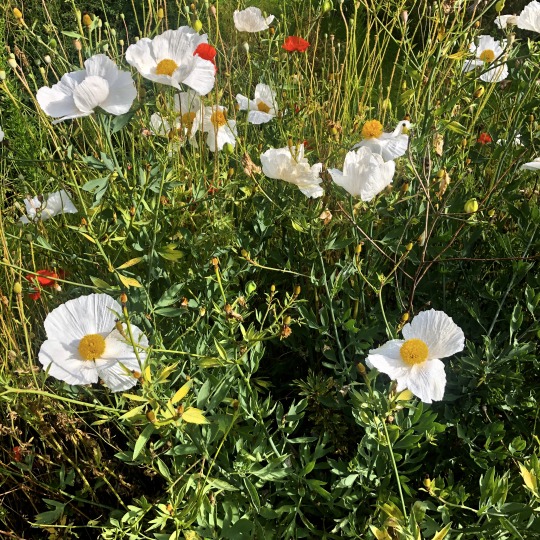
Friday, 13 November, saying goodbye... I made my way to Victoria in the morning, before work, to purchase one last social from Ole & Steen. After work we indulged in cheese, beers and Nell gave a very nice speech.
Mary Ellen painted this for me, and the plant and secateurs were gifts from colleagues.

The evening concluded with a stint in the jacuzzi - so very relaxing.

Plant of the week - a foreshadow of the next garden in which I shall be working
Cistaceae Cistus creticus L.
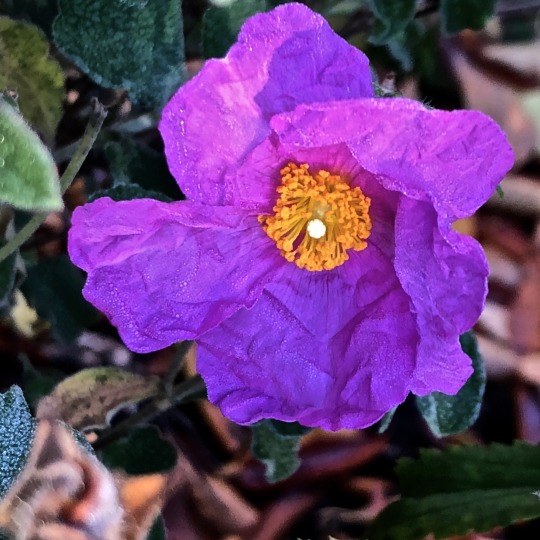
common name(s) - Cretan rockrose
synonym(s) - Cistus complicatus Spruner ex Nyman; C. creticus f. albus (O.E.Warb.) Demoly; C. creticus f. flavus Demoly; C. creticus subsp. trabutii (Maire) Dobignard; C. cupanianus C.Presl; C. dunalianus Sweet; C. garganicus Ten.; C. × incanus subsp. creticus (L.) Heywood; C. incanus subsp. creticus (L.) Heyw.; C. ladaniferus Stokes; C. polymorphus Willk.; C. rotundifolius Sweet; C. tomentosus Lam. [Illegitimate]; C. undulatus Moench; C. villosus L.; C. villosus f. albus O.E.Warb.; C. villosus var. creticus (L.) Boiss.; C. villosus var. rotundifolius (Sweet) Grosser; C. villosus var. trabutii Maire; C. villosus var. undulatus Grosser; C. vulgaris Spach; Ladanium officinarum Spach; Ladanum verum Raf.
infraspecific taxa - Cistus creticus subsp. corsicus (Loisel.) Greuter & Burdet; Cistus creticus subsp. eriocephalus (Viv.) Greuter & Burdet
conservation rating - none
native to - central and eastern European Mediterranean to Jordan
location - history beds, accession 1996-0376
leaves - shaggily hairy stems, leaves are slightly scented
flowers - variable in shade from deep purple-pink to rose pink, to 6cm across, with a yellow centre
habit - very variable, small, bushy, evergreen shrub, to perhaps 1.5m tall; highly branched shrub that measures between 30 to 140 cm with a more or less creeping stem but without actually taking root in the ground, with little strength to stay upright
habitat - distributed in calcareous romerales that inhabit soils with sandy characteristics; can be found growing near oak forests on the coast
pests - generally pest-free
disease - may suffer from nutrient deficiency when grown on very alkaline soils
hardiness - to -10ºC (H4)
soil -well-drained
sun - full sun, sheltered
propagation - seed, sow as soon as ripe and keep in cold frame or sow in spring; softwood cuttings in summer
pruning - does not respond well to hard renovation pruning
nomenclature - Cistaceae - Cistus - capsule, rock roses are conspicuous in fruit; creticus - from Crete, Cretan
NB - traditional herbal medicine, the leaves of Cistus have been used in the treatment of skin and inflammatory diseases (Hudson, 2009). Recent scientific research has confirmed the validity of this traditional herbal knowledge through studies that have demonstrated that Cistus leaf extractives have powerful antibacterial, antifungal, antiviral, and biofilm-breaking qualities (Rebensburg et al, 2015).
References, bibliography:
Gledhill, David, (2008) “The Names of Plants”, fourth edition; Cambridge University Press; ISBN: 978-0-52168-553-5
IUCN [online] http://www.iucnredlist.org/search [19 Nov 20]
Plant List, The [online] http://www.theplantlist.org/tpl1.1/record/kew-2723343 [19 Nov 20]
Plants of the World [online] http://plantsoftheworldonline.org/taxon/urn:lsid:ipni.org:names:168230-1 [19 Nov 20]
ProHealth [online] https://www.prohealth.com/library/cistus-a-natural-antibiotic-antiviral-and-biofilm-buster-6292 [19 Nov 20]
Royal Horticultural Society [online] https://www.rhs.org.uk/Plants/22292/Cistus-creticus/Details [19 Nov 20]
Warbleton Council [online] https://warbletoncouncil.org/cistus-creticus-13547 [19 Nov 20]
SARS-CoVid-2 update (active cases only) 2 November 2020

SARS-CoVid-2 update (active cases only) 8 November 2020

SARS-CoVid-2 update (active cases only) 16 November 2020

0 notes
Text
Get Started With Organic Gardening By Making Use Of These Suggestions.
Need Advice On Organic Gardening? Read On
Big farms use dangerous chemicals that may go into the water supply to make people very ill. Read this article to discover how.
Use companion plants. Companion planting will be the pairing of plants inside your vegetable garden, such as planting cabbage with tomatoes. Companion planting helps in reducing the issues with insect pests, as it attracts natural pest-controlling wildlife. Companion planting is yet another better use of the space inside your garden, because you basically have two plants from the same plot.
Coffee grounds and leftover coffee may be used to repel slugs. In case you have an issue with slugs in your garden, you can repel them effectively with coffee. You can sprinkle coffee grounds in the soil around your plants or use leftover coffee in the spray bottle to spray the slugs directly.
Begin a precise schedule to know when you ought to plant your seeds. Even when you are growing your plants indoors, you ought to adhere to a schedule that suits the season and outside temperature. Take some time on the schedule at the outset of a season and also you should be able to improve it the following year.
To maintain air flowing by your compost pile, stand a sizable PVC pipe with punched holes in the middle of your pile therefore the air flows up and down the pipe, then from the holes directly into the pile. The environment movement helps your soil decomposers make the heat needed to jumpstart the decay process.
Make mulch spreading easier together with the right tools. After laying out the mulch, make use of a flat-headed rake to efficiently spread the manure around. The tines of the rake help pull the mulch and spread it, while the flat side in the rake evens the area. Use the rake by using a pushing and pulling motion.
Attract positive bugs to your garden.Bugs like lady-bugs actually hunt natural predators to the plants aphids and caterpillars are organic gardening just some of the nasty critters that will experience the garden and eat the leaves of your plants. Lady bugs will be the natural predators to such pests and help the development of a great healthy garden by consuming pests.
Should you be experiencing an issue with slugs or any other insects, a wonderful organic contact pesticide is diatomaceous earth. You can get this at the most garden centers, and it also will come in a white powder form. It is really an abrasive material which will eliminate the critters by damaging your skin layer in the slugs and joints of the insects.
If your backyard soil isn’t conducive with an organic garden, try installing a raised bed. Inside the raised bed, you can create your own personal blend of soil and compost to have the ideal soil for raising your crops.Just make sure the bed jericho home improvements are at least 16 inches high in order that roots have room to flourish.
If you have low-growing weeds, such as lamium or chickweed, use a fast strategy to take them off. If your weeds have become into a mat, you can use a sharp spade to slice underneath the weeds. As soon as the weeds are cut, you must turn them over which will bury the leaves. The leaves will rot and nourish your soil.
A good time to water your organic garden is early every morning. By watering at the outset of the morning, you will be allowing any moisture that accumulates around the leaves to dissipate. This helps to discourage the increase of the mildew or fungus in the leaves that cold air and water would combine to make.
Organic Gardening
Buy your children enthusiastic about helping with your organic garden. Growing your backyard is the best way to teach your youngsters about nature while helping you to have enough time to bond using them.
When taking an organic route to control garden pests, try to produce the soil to allow healthy microbes to flourish. Earthworms can also be very important to organic gardening and they ought to be encouraged to stay in the soil. Once the soil is unhealthy, it is far from as immune to pests.
Making your own personal compost for organic gardening is quite simple and easy to accomplish. It offers soil of gardens with rich nutrients and keeps soil cool during summer months. You can utilize kitchen waste, sawdust, aquarium water, coffee grounds, tea leaves, rabbit or hamster droppings, a thin layer of lawn clippings, spices and eggshells in your compost.
Location is very important to organic gardening. Your garden should be in a area which get at least ten hours of sunlight throughout the summer. Before you start the garden, make sure that your location does not have any large obstructions that will cast shadows and block sunlight. Plants need a satisfactory volume of sunlight to reside.
Given that you’ve read this article, it can be probably clear to you it doesn’t go on a rocket scientist to grow organic produce. Whenever you can simply follow some easy-to-implement tips, you can be on the right track to gardening success. Memorize the following tips and place them to use and grow the garden you’ve been wanting
from Enviroscapesnw http://enviroscapesnw.com/get-started-with-organic-gardening-by-making-use-of-these-suggestions/
0 notes
Photo


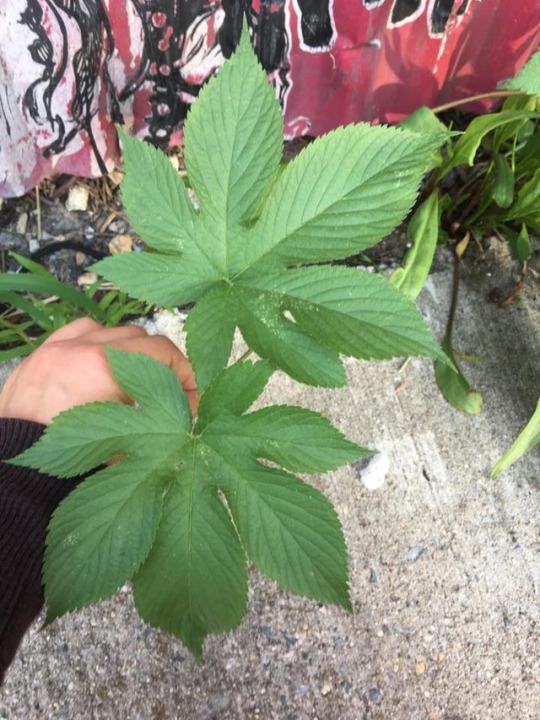
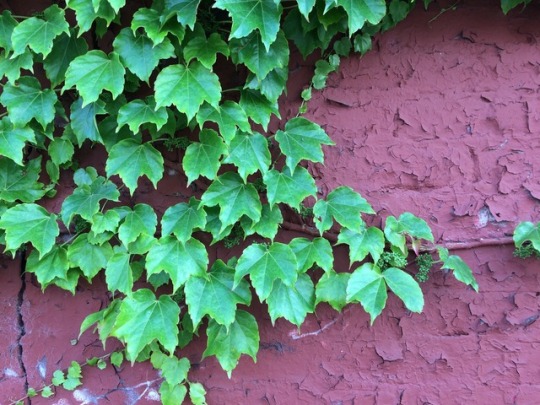
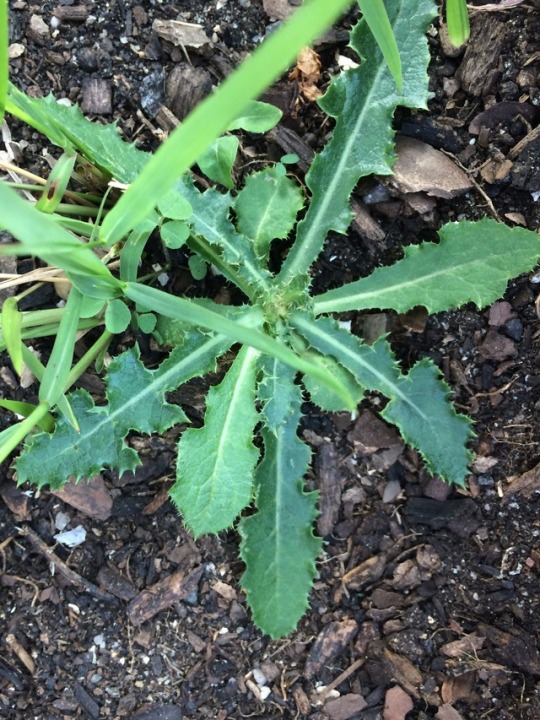



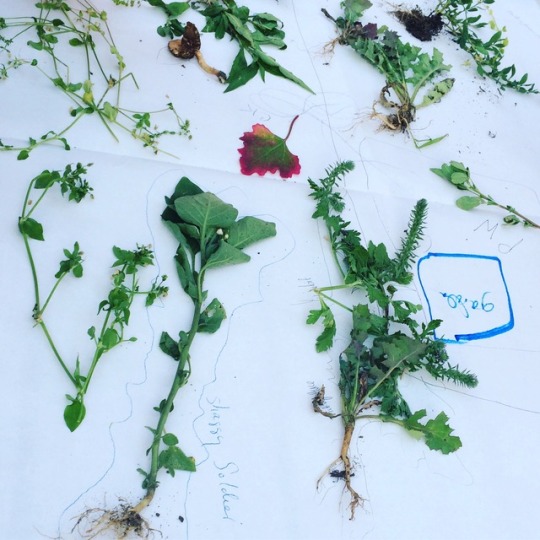
Some glimpses of the Weedy Resistance workshop at @pioneerworks in Red Hook Brooklyn, co-led by Marisa Prefer in collaboration with Sarah Chandler
SELECTED WEEDY PLANT SPECIES LIST:
Boston Ivy (Parthenocissus tricuspidata) - a flowering plant in the grape family native to eastern Asia in Japan, Korea, and northern and eastern China.
Climbing False Buckwheat (Fallopia scandens) - in the Knotweed family (Polygonaceae)
Black-bindweed (Fallopia convolvulus) is a fast-growing annual flowering plant in the family Polygonaceae native throughout Europe, Asia and northern Africa.
Prickly Lettuce (Lactuca serriola) - an annual or biennial plant in the dandelion tribe within the daisy family. Can be eaten as a salad, The Ancient Greeks also believed its pungent juice to be a remedy against eye ulcers and Pythagoreans called the lettuce eunuch because it caused urination and relaxed sexual desire. The Navajo used the plant as a ceremonial emetic.
Horseweed (Erigeron canadensis) - an annual plant native throughout most of North America and Central America. The Zuni people insert the crushed flowers into the nostrils to cause sneezing, relieving rhinitis. A tincture can be made from the dried flowering tops of the plants. Horseweed is a preferable material for use in the hand drill method of making friction fire.
Lambs Quarters (Chenopodium album) -extensively cultivated and consumed in Northern India as a food crop. Each plant produces tens of thousands of black seeds. These are high in protein, vitamin A, calcium, phosphorus, and potassium. Quinoa, a closely related species, is grown specifically for its seeds. The Zuni people cook the young plants' greens.
Chickweed (Stellaria media) annual plant native to Europe, Stellaria media is edible and nutritious, and is used as a leaf vegetable, often raw in salads.
Common milkweed (Asclepias syriaca) - ‘silk weed’ in German, ‘little cotton’ in Spanish can be used to make rope. Milky juices can be used for bug bites.
Henbit (Lamium amplexicaule) Henbit dead-nettle is native to the Mediterranean. The leaves, stem, and flowers of the plant are edible and have a slightly sweet and peppery flavor, similar to celery.
Common Dandelion (Taraxacum officinale) - a flowering herbaceous perennial plant of the family Asteraceae - The flowers are used to make dandelion wine, the greens are used in salads, the roots have been used to make a coffee substitute (when baked and ground into powder) and the plant was used by Native Americans as a food and medicine.
Bittersweet nightshade (Solanum dulcamara) - a species of vine in the potato genus Solanum. native to northern Africa, Europe, and Asia, but has spread throughout the world.
Oriental bittersweet (Celastrus orbiculatus) - The leaves are round and glossy, 2–12 cm (0.8–4.7 in) long, have toothed margins and grow in alternate patterns along the vines. Small green flowers produce distinctive red seeds which are encased in yellow pods that break open during autumn.
Shaggy Soldier (Galinsoga quadriradiata) - a species of flowering plant in the daisy family. Its native home is central Mexico.
Mugwort (Artemisia vulgaris) - native to temperate Europe, can be used as a tea, bug repellant and is edible.
Japanese Hops (Humulus japonicus) - Originally found in temperate parts of Asia - The composition and chemistry of the oils found in Humulus japonicus differs from its relative the common hop, Humulus lupulus. As a result, the Japanese hop is not used in the production of beer.
Virginia Pepperweed (Lepidium virginicum) - ative to much of North America, including most of the United States and Mexico and southern regions of Canada - The plant is edible. The young leaves can be used as a potherb, sauted or used raw, such as in salads. The young seedpods can be used as a substitute for black pepper. The leaves contain protein, vitamin A and vitamin C.
Tree of Heaven (Ailanthus altissima) - ative to both northeast and central China, as well as Taiwan - It was mentioned in the oldest extant Chinese dictionary and listed in countless Chinese medical texts for its purported ability to cure ailments ranging from mental illness to baldness. The roots, leaves and bark are still used today in traditional Chinese medicine, primarily as an astringent.
Virginia Creeper (Parthenocissus quinquefolia) - a species of flowering plant in the grape family, Vitaceae. It is native to eastern and central North America,
Spotted ladysthumb (Persicaria maculosa) - an annual plant in the buckwheat family, Persicaria maculosa contains persicarin and tannins. In medicine, redshank is used against diarrhoea and infections. The leaves and young shoots may be eaten as a palatable and nutritious leaf vegetable.
Asiatic Dayflower (Commelina communis) - an herbaceous annual plant in the dayflower family. In China it is used as a medicinal herb with febrifugal, antipyretic, anti-inflammatory, and diuretic effects. Additionally, it is also used for treating sore throats and tonsillitis.
Common Grapevine (vitis vinifera) - native to the Mediterranean region, central Europe, and southwestern Asia; Use of grapes is known to date back to Neolithic times, following the discovery in 1996 of 7,000-year-old wine storage jars in present-day northern Iran.
Japanese honeysuckle (Lonicera japonica) - significant source of food for deer, rabbits, hummingbirds and other wildlife.
Broadleaf Plantain (Plantago major) native to most of Europe and northern and central Asia; edible rich in protein, calcium, beta carotene, medicinal uses - for wounds/cuts
Seaside Goldenrod (Solidago sempervirens) native to eastern North America and parts of the Caribbean; highly tolerant of both saline soils and salt spray, and is usually found growing on coastal dunes and in salt marshes.
1 note
·
View note
Text
It’s Flower Fever Season
By Cynthia Brian
“Blossom by blossom the spring begins.” AC Shinburne
It took exactly one full day of warm sunshine a week before the vernal equinox for the garden to spring into action. Everywhere I looked, bulbs, wildflowers, perennials, and plants burst into blooms. Muscari, Dutch iris, tulip, bergenia, freesia, hyacinth, lamium, rosemary, honeysuckle, calendula, California poppy, and even my outdoor cymbidium orchids strained for the solar shine. Deciduous trees are budding, leaves unfurling, all of nature is alive with expectation. With the abundance of rain we’ve enjoyed this winter, our gardens are determined to showcase their brilliance. Wherever you look, beauty awaits.
Spring is by far my favorite season of the year. As I witness landscapes awakening from their long hibernation, I am anxious to get my hands in the dirt. Weeds are abundant, yet they are easy to pull. Spading is excellent exercise burning 179 calories in just fifty minutes of digging. Snails and slugs have begun their migration making it necessary for us to be vigilante. New growth and tender seedlings are their favorite food. Frogs have begun their annual mating calls while the chirping birds are busy building nests. As tempted as we may be, it’s still too early to sow vegetable and flower seeds outdoors. It is time, however, to get lawns into shape and prepare the soil for April planting. Allergy sufferers need to be on the alert as pollen is abundant in the air.
We have so much work to do to get ready for the next season. Make a play date with Mother Nature and enjoy fun in the sun soaking up vitamin D.
Spring ahead!
Cynthia Brian’s Gardening Guide for March Magic
INSPECT your irrigation system. Mud might be clogging sprinkler heads while grass or lawn may have grown over the sprinklers. Spend time to get your system working properly before the heat begins.
MOW lawns without the bag…”sin bolsa” en espanol. The lawn cuttings are filled with nitrogen and nutrition that will green up your lawn. Don’t waste that free fertilizer. If you find that clumps are left behind, rake or blow them into the lawn.
SOW lawn seed now. If you want to add a bit of color that will withstand dogs and kids, isotoma called blue star creeper looks great with its tiny blue flowers. Clover is always green boasting pink or white flowers. For a real conversation piece, create a living rug with a variety of ornamental grasses including ajuga, woolly thyme, pink chintz thyme, creeping speedwell, Irish moss, and brass buttons.
GROW red and golden beets for their anti-inflammatory qualities. With only six grams of sugar in the average two-inch diameter bulb, beets lower blood glucose and increase insulin sensitivity. The leaves are delicious sliced, diced, raw, or steamed. Rich in fiber, folate, potassium, and vitamins A and C, beets are heart healthy, lowering blood pressure while providing plenty of antioxidants. After boiling, save the water to add to your juice or other veggies.
WASH patio furniture with a solution of water and bleach to remove mildew or mold that has grown over the winter.
CUT a few errant shoots from any budding fruit tree to add to a vase of water. You’ll enjoy watching the buds burst to blossoms over several weeks.
PLAN your vegetable garden by creating a map of what you want where. Design in geometric patterns, semi-circles, and circles for whimsy and interest.
CLEAN birdbaths, fountains, bird feeders, and birdhouses to attract songbirds to reside in your garden.
CONTINUE to pick up fallen camellia blossoms until the blooming ends next month. Do not leave the dead blooms on the ground.
ADD a trellis as a focal point in your landscape for climbing blue morning glory, clematis, or red runner beans.
FERTILIZE grass, trees, shrubs, and perennials.
BRING inside plants outside for a good soaking and a few hours of morning sunlight. Check for insects and wipe the exterior of the containers as well as any leaves with a damp cloth to remove the dust.
ASSIGN kids an area to grow their favorite vegetables. Research indicates that children who garden eat healthier. Tomatoes, peppers, zucchini, radishes, carrots, beans are all easy-to-grow.
PICK snails and slugs off of plants at night by using a flashlight. Beer in saucers attracts snails or bait with organic pellets.
CHECK that you have proper, well-made garden tools. You’ll need a wide handle shovel, trowel, knee cushion, hoe, pick, and pruning shears in at least two sizes. The right tools make the job simpler and faster.
ORDER the Whole Seed Catalog from Baker Creek if you seek rare heirloom seeds. When you grow your own food, you’ll know you are providing your family with non-GMO, pesticide, and chemical free nutrition. www.rareseeds.com
PRE-ORDER my forthcoming garden book, Growing with the Goddess Gardener, Book I in the Garden Shorts Series. All pre-orders will receive extra goodies such as heirloom seeds, bookmarks, and more. Email me for details, [email protected]. 25% of the proceeds benefit the 501c3 Be the Star You Are!® charity. Book is expected to be available in April, just in time for spring planting.
A Garden in a Box: If you don’t think you are much of a gardener, you can always order a pre-planned garden from High Country Gardens. Type in your zip code and you’ll easy see what will work for you. You’ll get instructions, a design map, and special plants. Visit http://www.highcountrygardens.com
Flowers, Fotos, and Food: Artist and photographer Anne Morrison Rabe’s Spring Flowers, exhibit begins Thursday, March 23 at Homemade Kitchen, 337 Rheem Boulevard, in Moraga. Check it out and get inspired.
Win $50,000 for your Garden: I have been selected as a judge in America’s Best Gardener Contest. America’s Best Gardener is the premier event for recognizing and celebrating the talents of indoor and outdoor gardeners! Show the world that your thumb is the greenest by showing the world pictures of your garden today! You can win $50,000 so I encourage you to enter. http://www.americasbestgardener.com
WEED, weed, weed, then weed again.
EMAIL me when you need a consultation.
CATCH flower fever. It’s contagious and oh, so healthy.
Happy Gardening and Happy Growing!
Read more: https://www.lamorindaweekly.com/archive/issue1102/Digging-Deep-Catch-Flower-Fever-this-month.html
©2017
Cynthia Brian, The Goddess Gardener, is a New York Times best selling author, actor, radio personality, speaker, media and writing coach as well as the Founder and Executive Director of Be the Star You Are1® 501 c3.
Tune into Cynthia’s Radio show at www.StarStyleRadio.net
Available for hire for any project.
[email protected]
www.GoddessGardener.com
925-377-STAR
#march gardening rain gaelic emerald island st. patricks day cynthia brian goddess gardener valentines star style lamorinda weekly#spring march gardening win $50 000 growing with the goddess gardener azaleas calla lilieslamorinda weekly weeds birds butterflies cynthia br
0 notes
Text
Deaf nettle benefit.
Lamium album is a plant not relating to Nettle diclinous, are different families, but they are both are benefit for human. Lamium is useful families to labia, and in this family all herbs using in human at kitchen, and in healing. And deaf calling her, that she is not burning, that a nettle diclinous. And this beautiful nettle blooming beautiful, the best honey plant.And not remove her as weed in your garden, leave her for bees, and prepare and cook from her taste and benefit tea.
Flowers are base using in therapy, they are having abundant mucus, tannins, saponins, flavonoids, choline, histamine, alkaloid thiamine. And from vitamins are vitamin C , in leafs are 15 perc. for carotene. And for organism effect as ant inflammation, anti seizure, calming, astringent, diuretic, blood stopping, and dilutes phlegm, weak calming effect.
And in medicine flowers infusion using in ache menses, destroys, spasms urinary bladder, inflammation for kidney pelvis and nephritis, lung tuberculosis, bronchitis, scrofula, skin diseases, diarrhoea, infusion, powder of corollas using externally in injures, eczema, urticaria, exudative diathesis, wounds, burns. Flowers and herb infusion are using in itching rashes and ulcers. Juice of leafs, flowers use internally and externally in children s diathesis, boils, skin itches. Flowers infusion for gargle throat, as in angina anti inflammation. Flowers enters in herbs which helping in allergy dermatitis, psoriasis, ulcers.
One tbl.sp. flowers or dried chopped leafs of lamium white, cook in glass for the hot water, infuse hour, filter, use 1/3 glass for 4 times/day before meal as in insomnia, hysteria, nervousness high, allergy displays, as urticaria, boils.
4-6 tra.sp. flowers adding in 2 glasses for the hot water, infuse hour, filter, use 1/3 glass for three times/day before meal in urinary bladder diseases and urinary ways, gastrointestinal highway, diarrhoea, bronchitis, asthma .
3 tbl.sp. fl. lamium adding in 0.5 l. of vodka, infuse week in warm place, filter, use on 30 drops for 3 times/day before meal, dilute in 100 ml. of water.
One tbl.sp. flowers adding in glass of hot water, infuse 30 min, filter, gargle throat and mouth cavity for 4 times/day after meal in angina, stomatitis, teeth ache.
6 tbl.sp. dried flowers of lamium, lead till boiling in one l. of water, boil 5 min. Turn off fire, infuse till a cooling, filter, apply compresses in burns, boils, skin diseases.
From fresh leafs press juice, and of flowers, use 2 tbl.sp. with honey for 4 times/day in ischaemic heart diseases, diarrhoea, top breath diseases, urethritis, cystitis, neurasthenia, hysteria.
Avoiding using on pregnancy time, lamium remedies strengthening uterine tone, chronic hard stool, child s age, low pressure and other diseases tie with a forming blood clots are too avoiding using lamium. And on lamium also having bad enduring and allergy. If you are going curing allergy with her, thus check before her use that she is not causing allergy, but better visit allergist doctor.
By Filin A. Biologist, candidate for biologic science.
To paint this plant, as convert this image, please check my links on my right blog side.
from Valga s health news,gardening,and cooking ,and beauty . https://ift.tt/dWlc1pw
via https://ift.tt/WNvytRm
0 notes
Photo


The Eclipse was over. The elements had balanced, the swell of power had passed, the Tangled Wood was quiet. Flameforger's had come and gone, and soon enough it would be Starfall.
But some shadowlings couldn't come down from the high. They stayed drunk on power they no longer had and braved places they shouldn't have been. Places that made Lamium desperately wish he hadn't chosen to be the clan's Night Ranger.
It wasn't so different from his father's job. He helped travellers, made sure the territory itself was protected, and generally promoted peace and safety to all of Aphaster's denizens and visitors. Between an increase in night life outside of Bramble Step and that thing with Eos, Lamium felt more necessary and proud than ever.
But now, deep in the Hewn City, he was frightened. The moon was too large in the starless sky. He couldn't believe for a moment that it had ever eclipsed or been eclipsed by anything. The shadowlings were cackling--dumb visitors made endlessly brave by experiencing too much power at too young an age. Oblivious of danger or their own mortality, while he didn't even dare call out to them.
This terrified silence was cut only by the rapid-fire beating of his heart, which intensified to a violent drumming when their laughter abruptly cut out.
He peeked around a crumbling corner, squinting in the dark not to see but to hide the glint of his sun-colored eyes. He saw them--one standing still and staring while the other meandered. He thought he saw something glinting from inside the shadows in a color he didn't quite understand. He thought he saw the smooth surface of a pearl.
The dragon who wasn't moving shuddered and slumped to the ground. The thing in the shadows didn't reach for the body, but it let out an immensely satisfied groan. It was a sound that made Lamium think of every time he had gorged himself as a hatchling after a long day of playing.
The other shadowling came back, and the sight of their friend slumped and visibly dead tore their illusion of invincibility to shreds. They shrieked. The noise was like a physical force in the silence of the ruins. Dust snowed down from abandoned windows. The thing in the shadows drew back and disappeared, and the earth rumbled like a creature turning in its sleep.
Lamium felt it. He could never have named it or even described the shape of it, but every bone in his body and every drop of his magic knew something wrong was stirring. His mane stood on end, and against his better judgement he rushed to save the wayward shadowling.
He was too late. It wrapped the howling dragon in itself, all solidly black with a there-and-gone sheen of gold like the scales of a fish hitting the moonlight just right. It was like the folds of a mourning veil being carried on a malevolent breeze. The cries of its latest victim were drowned out not by any squeezing or devouring. The veil flowed into their mouths and filled them from within and then crept over their scales, and then Lamium could not see them anymore.
Run. Run! His feet wouldn't move. His wings wouldn't spread. The thing crept toward him, massive and billowing.
"Run!"
Another imperial rammed into him--pushing him out of the way as those first fabric-like tendrils bore down. Golden runes shone along his body as he tore and bit at the veil. Lamium was once again frozen, not by fear, but by conscience. He knew this imperial was not like he was. They had four wings and a strange pointed face covered in black fur. But though they had run in without any seeming reservation to save Lamium, the thing they fought was massive. Blotting out the sky and somehow making the darkness even more oppressive. He had to help...!
You will both die here.
Was it speaking to him? "Please," he begged between rapid, shallow breaths. "Please just let us go home."
It does not speak, the voice said tartly. You know that. Pledge yourself to me, and I will see you both safe.
"Who are you?"
Do you pledge?
Lamium looked again at the other imperial. They clamped and bit but the thing still poured itself mindlessly into its mouth. Eventually they would not be able to chew it apart fast enough. They would die. And so would he.
"I pledge! I swear myself to you, whoever you are! Please!"
"And that's all you remember?" asked Penitence.
Lamium stared at the marble table. He was back in the sun, but his eyes were plagued by dark circles and the entire world seemed similar somehow.
"I remember the pain," he whispered. "I remember the way the runes felt, so cold they burned." His head drooped, and he rubbed at his arms, freshly emblazoned with runes all blue and rusty brown and faintly glowing. "She said...she was the Veiled Moon..."
“And you?”
The other imperial--Shekhinah--looked up from a warm cup of tea with a too bright smile. “Yes, what about me?”
Penitence sighed, and Perilous picked up where he left off. “Do you remember what happened after that?”
“Mmmm~ I wasn’t really paying attention. I had a mouth full of that gross thing and it tastes terrible, just terrible. Your tea is delicious by the way, very floral.”
“...Are you aware you were going to die, Shekhinah?”
“Oh absolutely,” they answered with impenetrable blitheness. “But I couldn’t just let this young man die when he tried to save that nocturne.”
Penitence pressed his lips together and tried not to rub at his temples. “I’ll be keeping you both for observation. At the very least until we get Ashes in to look at those runes.”
There was a barely audible pit-pat of tears hitting the wood, and Lamium curled into himself and wailed like a frightened child. “I want my mom...!!”
Penitence and Perilous shared a look. But while there was a softness born of understanding in Penitence’s eyes, he firmly shook his head. Lamium and Shekhinah could not leave or see other dragons until they were cleared by the Tribune of Magic, and the quarantine extended to Penitence and Perilous as well.
This was for everyone’s safety.
#Flight Rising#C: Lamium#c: shekhinah#oh boy shekhinah is the 'I'm just happy to be included' type#Voices from the Eclipse
17 notes
·
View notes
Text
Flower Fever
“Blossom by blossom the spring begins.” AC Shinburne
It took exactly one full day of warm sunshine a week before the vernal equinox for the garden to spring into action. Everywhere I looked, bulbs, wildflowers, perennials, and plants burst into blooms. Muscari, Dutch iris, tulip, bergenia, freesia, hyacinth, lamium, rosemary, honeysuckle, calendula, California poppy, and even my outdoor cymbidium orchids strained for the solar shine. Deciduous trees are budding, leaves unfurling, all of nature is alive with expectation. With the abundance of rain we’ve enjoyed this winter, our gardens are determined to showcase their brilliance. Wherever you look, beauty awaits.
Spring is by far my favorite season of the year. As I witness landscapes awakening from their long hibernation, I am anxious to get my hands in the dirt. Weeds are abundant, yet they are easy to pull. Spading is excellent exercise burning 179 calories in just fifty minutes of digging. Snails and slugs have begun their migration making it necessary for us to be vigilante. New growth and tender seedlings are their favorite food. Frogs have begun their annual mating calls while the chirping birds are busy building nests. As tempted as we may be, it’s still too early to sow vegetable and flower seeds outdoors. It is time, however, to get lawns into shape and prepare the soil for April planting. Allergy sufferers need to be on the alert as pollen is abundant in the air.
We have so much work to do to get ready for the next season. Make a play date with Mother Nature and enjoy fun in the sun soaking up vitamin D.
Spring ahead!
Cynthia Brian’s Gardening Guide for March Magic
INSPECT your irrigation system. Mud might be clogging sprinkler heads while grass or lawn may have grown over the sprinklers. Spend time to get your system working properly before the heat begins.
MOW lawns without the bag…”sin bolsa” en espanol. The lawn cuttings are filled with nitrogen and nutrition that will green up your lawn. Don’t waste that free fertilizer. If you find that clumps are left behind, rake or blow them into the lawn.
SOW lawn seed now. If you want to add a bit of color that will withstand dogs and kids, isotoma called blue star creeper looks great with its tiny blue flowers. Clover is always green boasting pink or white flowers. For a real conversation piece, create a living rug with a variety of ornamental grasses including ajuga, woolly thyme, pink chintz thyme, creeping speedwell, Irish moss, and brass buttons.
GROW red and golden beets for their anti-inflammatory qualities. With only six grams of sugar in the average two-inch diameter bulb, beets lower blood glucose and increase insulin sensitivity. The leaves are delicious sliced, diced, raw, or steamed. Rich in fiber, folate, potassium, and vitamins A and C, beets are heart healthy, lowering blood pressure while providing plenty of antioxidants. After boiling, save the water to add to your juice or other veggies.
WASH patio furniture with a solution of water and bleach to remove mildew or mold that has grown over the winter.
CUT a few errant shoots from any budding fruit tree to add to a vase of water. You’ll enjoy watching the buds burst to blossoms over several weeks.
PLAN your vegetable garden by creating a map of what you want where. Design in geometric patterns, semi-circles, and circles for whimsy and interest.
CLEAN birdbaths, fountains, bird feeders, and birdhouses to attract songbirds to reside in your garden.
CONTINUE to pick up fallen camellia blossoms until the blooming ends next month. Do not leave the dead blooms on the ground.
ADD a trellis as a focal point in your landscape for climbing blue morning glory, clematis, or red runner beans.
FERTILIZE grass, trees, shrubs, and perennials.
BRING inside plants outside for a good soaking and a few hours of morning sunlight. Check for insects and wipe the exterior of the containers as well as any leaves with a damp cloth to remove the dust.
ASSIGN kids an area to grow their favorite vegetables. Research indicates that children who garden eat healthier. Tomatoes, peppers, zucchini, radishes, carrots, beans are all easy-to-grow.
PICK snails and slugs off of plants at night by using a flashlight. Beer in saucers attracts snails or bait with organic pellets.
CHECK that you have proper, well-made garden tools. You’ll need a wide handle shovel, trowel, knee cushion, hoe, pick, and pruning shears in at least two sizes. The right tools make the job simpler and faster.
ORDER the Whole Seed Catalog from Baker Creek if you seek rare heirloom seeds. When you grow your own food, you’ll know you are providing your family with non-GMO, pesticide, and chemical free nutrition. www.rareseeds.com
PRE-ORDER my forthcoming garden book, Growing with the Goddess Gardener, Book I in the Garden Shorts Series. All pre-orders will receive extra goodies such as heirloom seeds, bookmarks, and more. Email me for details, [email protected]. 25% of the proceeds benefit the 501c3 Be the Star You Are!® charity. Book is expected to be available in April, just in time for spring planting.
A Garden in a Box: If you don’t think you are much of a gardener, you can always order a pre-planned garden from High Country Gardens. Type in your zip code and you’ll easy see what will work for you. You’ll get instructions, a design map, and special plants. Visit http://www.highcountrygardens.com
Flowers, Fotos, and Food: Artist and photographer Anne Morrison Rabe’s Spring Flowers, exhibit begins Thursday, March 23 at Homemade Kitchen, 337 Rheem Boulevard, in Moraga. Check it out and get inspired.
Win $50,000 for your Garden: I have been selected as a judge in America’s Best Gardener Contest. America’s Best Gardener is the premier event for recognizing and celebrating the talents of indoor and outdoor gardeners! Show the world that your thumb is the greenest by showing the world pictures of your garden today! You can win $50,000 so I encourage you to enter. http://www.americasbestgardener.com
WEED, weed, weed, then weed again.
EMAIL me when you need a consultation.
CATCH flower fever. It’s contagious and oh, so healthy.
Happy Gardening and Happy Growing!
Read more: https://www.lamorindaweekly.com/archive/issue1102/Digging-Deep-Catch-Flower-Fever-this-month.html
©2017
Cynthia Brian, The Goddess Gardener, is a New York Times best selling author, actor, radio personality, speaker, media and writing coach as well as the Founder and Executive Director of Be the Star You Are1® 501 c3.
Tune into Cynthia’s Radio show at www.StarStyleRadio.net
Available for hire for any project.
[email protected]
www.GoddessGardener.com
925-377-STAR
0 notes
Link
BALLI BABA Çok Yıllık | 0,2-0,5m | 4-10 Aylar | Ca,Ho,Na | Çiçeği | Otu Ballıbaba Taubnessel Lamium album Ak ballı baba Beyaz ballı baba Familyası: Ballıbabagillerden, Lippenblütgwâchse, Lamiaceae(Labiatae) Drugları: Ballıbaba çiçeği; Lamii albi flos Ballıbaba otu; Lamii albi herba Ballıbabanın sadece çiçekleri çay, tentür ve natürel ilaç yapımında kullanılır, nadiren de otunun kullanıldığı olmaktadır. Giriş: Ballıbabagiller ailesine dahil olan Ballıbabanın oldukça çok türü vardır, fakat bunlardan sadece ak ballıbaba tıbbi maksatlı kullanılır. Ak ballıbabanın haricinde Sarı ballıbaba; Lamium galeobdolon, kan kırmızısı ballıbaba; L.purpureum, Benekli ballıbaba; L. Maculatum ve Sarmalı ballıbaba; L.ampılexicauleyi sayabiliriz. Lamium eski yunanca da << Lamos>> kelimesinden türemiş olup, yutak anlamına ve Latince album kelimesi beyaz anlamına gelir. Almanca Taubnessel denir. Taub uyuşuk, Nessel ısırgan yani yakmayan ısırgan otu anlamına gelir. Türkçe de ballıbaba denmesi çiçeklerinin bal tadında olması nedeni iledir. Ballıbaba çok eskilerden beri kadın hastalıklarına ve özelliklede beyaz akıntıya karşı kullanılmıştır. Avrupa, Asya ve Kuzey Amerikanın ılıman bölge¬lerinde özelliklede nemli, kumlu ve humuslu topraklarda, Türkiyenin ise genellikle Marmara, Karadeniz ve Doğu Anadolu da yabani olarak yetişir. Botanik: Ballıbaba 20-50cm arasında dikine yükselen, çatallaşmayan ve köşeli bir gövdeye sahiptir. Yaprakları kalp, yumurta veya mızrak şeklinde ve yahut ta yarıya kadar kalp ve yarıdan sonra üçgen şeklinde olabilir. Yapraklarının kenarları kertikli, üzeri pürtüklü, koyu yeşil renkli kısa saplı üzeri narin tüylü, karşılıklı ve bir sonraki ile çaprazdır. Çiçekleri yaprak saplarının hemen üstünde gövdenin kenarına halka gibi oturmuş ve bu halka üzerinde 6-12 adet çiçekten meydana gelir. Çiçek taç yapraklarının üst dudağı miğfer şeklinde, alt dudağı iki loplu beyaz renkli ve iç kısmında döllenme tozlukları bulunur. Arı ve yaban arıları çiçeklerin bitki özünü emmek istedikleri zaman çiçek tozu arıların üstüne yapışır ve böylece çiçek döllenmiş olur. Ballıbaba otu ile Kedi başı otunu birbirinden ayırmak oldukça zordur. Fakat dikkat edince bazı farklılıkları görebiliriz. Bu farklardan bazıları; kedi başı otu çatallaşır, iki taç yaprakların üst dudakları (Miğferleri) alttakinden küçüktür ve yaprak sapları daha uzundur. Yetiştirilmesi: Ballıbaba ağaç altlarında veya gölgeliklerde daha iyi yetişir. Tohumların yetiştirmek mümkün olduğu gibi kök sürgünleri ile de yetiştirilebilir. Hasat Zamanı: Mayıstan Ekime kadar sadece çiçekleri toplanır gölgede 35˚yi geçmeyecek sıcaklıkta kurutulur şayet tentürü yapılacak ise taze olarak işlenir. Maalesef şifalı bitkiler toplama, kurutma, paketleme ve depolama işlemleri sırasında çok yanlışlar yapılmaktadır. Bitkinin şifalı kısmı yaprak veya çiçekleri ise asla Güneş altında kurutulmaz ve mutl¬aka gölgede kurutulmalıdır. Ayrıca örneğin bitki 5 günde kurudu ise, 2 gün daha kurumada bırakmak mahzurludur, çünkü birleşimindeki eterik yağları kaybettiğinden kalitesi düşer. Sadece bitki kökleri Güneşte kuru-tulur ve kurur kurumaz hemen paketlenip depolanması gerekir. Şifalı bitkilerin Aktarlarda açıkta satılması kalitesini kısa sürede düşürür ve etkisini oldukça azaltır. Birleşimi: Ballıbaba çiçeğinin birleşimindeki maddeleri önemine göre şöyle sıralayabiliriz; a) İridoitglikozitler; lamalbid ve caryoptosid b) Secoiridoitglikozitler; albosid A ve albosid B c) Biogen aminler; tyramin, histamin ve metilamin d) Flavonitglikozitler; Quercimetrin (Quercetin-7-β-glikozit), Kâmpferol-3-diglikozit ile az miktarda Katechin taninler (Catechin taninler) içerir. e) Ayrıca müsilajlar, eterik yağlar, saponinler, zamk, şeker, kolin ve az miktarda alkaloit ve fenol karbonik asitler içerir. Tesir şekli: Damarları büzücü, mukoza zarını koruyucu, kanı temiz-leyici, iç kanamayı durdurucu, iltihapları önleyici ve mantarları yok edi-cidir. Kullanılması: a) Üniversite kliniklerinde modern anlamda araştırmalar yapılmamıştır. Bu nedenle ballıbaba yerine kadın hastalıklarında Gökçek İksir tercih edilir, çünkü çok çok etkilidir. b) Komisyon Enin 14.07.1993 tarih ve 128 nolu Monografi bildirisine göre Ballıbaba çiçeği başta mide bağırsak rahatsızlıklarına; mide zafiyeti, tıkanma ve şişkinliğe karşı ve de bağırsakları kuvvetlen¬dirmek için kullanılır. Ballıbaba çiçeği ayrıca adet rahatsızlıkları, kadın hastalıkları uyuyama, sinirlilik, karaciğer, böbrek ve kalp zafiyetine karşı da diğer bitkilerle birlikte harman çayı olarak kullanılır. c) Halk arasında; kadın hastalıklarından beyaz akıntı, menopoz ve adet rahatsızlıkları ile varis basur ve idrar tutamamaya karşı kullanılır. Açıklama: Her beyaz akıntının doktorlar tarafından iyice incelenmesi ve ona göre tedavi edilmesi gerekir. Çünkü hastalık yapan mantarların (candida albicans) veya parazitlerin (trichomonaden) iyi olup olmaya-caklarının tespiti gerekir. Vajinada faydalı laktik asit bakterileri hem burada beslenirler hem de vajinayı korurlar. Bu nedenle beyaz akıntı grimsi, pembe, sarı, kırmızı veya kahverengimsi olabilir ve de kokmaya başlayabilir. Akıntının renginin değişmesi veya koyulaşması ve de koku-sunun değişmesi önemli bir hastalığa delalet olabilir. Çayı: 2 kahve kaşığı Ballıbaba çiçeği demliğe konur ve üzerine 300-500 ml kaynar su ilave edilerek 5-10 dakika demlenmeye bıraktıktan sonra süzülerek içilir. Çay Harmanları: B. Vonarburga göre beyaz akıntıya karşı çay; >20 gr Koyungözü çiçeği >20 gr Biberiye yaprağı >20 gr Papatya çiçeği >20 gr Ballıbaba çiçeği >10 gr Atkuyruğu otu Gökçek Beyaz Akıntı çayı >25 gr Ballıbaba çiçeği >25 gr Aslanpençesi otu >25 gr Atkuyruğu otu >25 gr Civanpercemiotu Gökçek İltihaplı kadın hastalıklarına karşı çay; >20 gr Biberiye yaprağı >20 gr Ballıbaba çiçeği >20 gr Isırgan otu >20 gr Civanpercemiotu >20 gr Ayı üzümü yaprağı Dr. J.Reinharda göre kan kanserine karşı çay; >20 gr Söğüt kabuğu >12 gr Sefa çiçeği >12 gr Atkuyruğu otu >12 gr Isırgan otu >10 gr Karakafes kökü >10 gr Ceviz yaprağı >10 gr Centiyan kökü >10 gr Ballıbaba çiçeği >4 gr Boy otu tohumu J.Karla göre beyaz akıntıya karşı çay; >20 gr Ballıbaba çiçeği >20 gr Aslanpençesi otu >20 gr Ceviz yaprağı >20 gr Adaçayı yaprağı >20 gr Biberiye yaprağı >20 gr Çilek yaprağı Dr. J.Reinharda göre böbrek büyümesine karşı çay; >20 gr Papatya çiçeği >20 gr Ballıbaba çiçeği >20 gr Atkuyruğu otu >20 gr Kekik otu >20 gr Yoğurt otu Homeopatide: Ballıbaba çiçekleri ezilmeden toplanır, taze olarak bir şişeye konur ve üzerine %70lik alkol ilave edilerek 4-6 hafta bekledikten sonra süzülerek Homeopatide <<Lamium album>> ismi ile anılan tentür elde edilir. Bu tentürden günde 3-5 defa 10-15 damla 4-6 hafta süreyle alınır. Yan Tesirleri: Bilinen bir yan tesiri yoktur.<
Alternatif Tıp ve Alternatif Tedavi, bitkisel ürünler, sifamarket
0 notes
Note
1, 2, 3, 4, 13, 17 (cough), 18, 42, 43, 44, 45, 74, 77, 78 :>
1. (Answered Here)
2. What kind of combatdoes your clan specialize in? Physical? Magical? Bit of both? Or are they morefond of subterfuge?
Magical combat is very much the order of the day, but justabout every dragon in the clan is more than capable of throwing a good punch.If they can fight in any capacity, you should be worried about them punchingyou in the throat once all their other options are exhausted.
Subterfuge is the domain of two dragons: Bestealcian, theUmbra Wolf and Actias, the Smoke Gyre. The fore only serves the Queen and thelatter has served the clan and its allies since the days of the old dynasty.Sometimes they are directly at odds in their goals, so it is very difficult forenemies or outsiders to keep up with whether the Smoke Gyre is even a real partof Clan Aphaster. Most of his clan mates don’t even know his real name.
3. What kinds of weaponsdo your dragons use? If your dragons use actual physical weapons how do theyhold them (assuming they don’t use claws/teeth)? If they use magic do they havesome sort of focus like a staff?
It varies from dragon to dragon and by their expertise.Aphaster dragons spend a significant amount of their time in humanoid shapesdue to an agreement with the local beastclans (in short: don’t trample theSummerlands; the Centaurs grow grain there and the Serthis hunt small game thatwould otherwise be pests).
Most physical fighters favor swords of some kind, whether it’sQueen Telos’ elegant saber, Arcanus’ unadorned broadsword, or Opalite’s saw-toothedcleaver. But there’s also a pretty lively sect of hand-to-hand fighters thateither use their fists or specialize in claw weapons. (Note: Queen Telostrained with Perilous, the best pugilist in the clan, and while she’s good atwielding her saber, she’s a demon at hook punches). Bestealcian and Actias arealmost never seen in humanoid form. The latter is a tooth and claw fighter whospecializes in quick death and incapacitation. The fore is a proper fighter andutilizes a variety of weapons, from an ice pick to arrows to a bladed alloy fanfrom the Blacksand Annex that also doubles as a shield.
Magic among my clan members is mostly for mundane purposes. Amongcombat magic users there’s Lutia, the aforementioned nuke, and she’s anArchmage so she doesn’t need anything but her will to cast magic. There’s Tawnywho isn’t an Archmage but is a high level pyrokinetic who can burn just aboutanything so long as it’s in his line of vision. Arcanus is a magic knight, hemostly uses enchantments and quick spells with his sword as a focus.
Then there are the witches, who are an entirely differentmatter but are next to harmless given they only use their powers for the spirittheir coven is serving at the time.
4. What or who would bemost likely to attack your clan at this point in time? Is your clan aware ofthis potential threat?
From above: An additional team exists solely to deal withThings trying to come through the place the Chalcedony Seat almost crackedthrough the veils, but they’re not strictly military.
Outsiders are the problem right now. Beings that don’t comefrom Sornieth being attracted to the rift . They don’t know about it yet, butit’s going to be factoring in veeery soon.
13. How “fairly” doesyour clan fight? Are they honorable even when things look grim? Are theywilling to get their hands a little dirty?
The clan is very multi-elemental and the members are allvery different. There’s no one who would say…use a meat shield in a fight. Butthey might throw some pocket sand at you and some of them firmly believe thatblackmail is a useful and perfectly reasonable tool against anyone who has madeit clear they intend to be a problem.
On the macro and in governmental affairs, the clan fightsfairly—very much lawful alignment—but they’re not above finding loopholes orabusing plausible deniability. Example: In the old clan, Actias prevented a warbetween the clan and oncoming harpies by snatching two males from their homeroost and threatening to kill them. This was framed as an independent action todefend his son, Iblis, but really it was so the clan could avoid war, scareaway the harpies, and not damage their reputation with other beastclans theywere friendly with.
Though it helps somewhat more now that unlike then, Telosreally doesn’t know what Actias is doing half the time and has been advised byActias himself to have Bestealcian hunt and kill him if it becomes politicallynecessary.
17. What sort of thingsdoes your clan look for in potential allies? In this case I mean generalattitude and moral code.
They prefer clans that don’t harbor shade creatures,emperors, demons, or more sinister forms of Outsider, but if enough trust isbuilt up it’s easy for them to overlook those things (see: Clan Feldspar).Really so long as your clan isn’t clearly evil or just more trouble than they’reworth, there’s not much in the way of central dogma that will see youautomatically turned away.
The only real dealbreaker is a clan whose overall philosophyinherently involves disharmony with the beastclans. Aphaster has greatrelations with most of the main beastclans save the corven and the harpies, andthey’re trying to keep it that way. A harpy runs the creamery, and she’s one ofthe most beloved members of the clan, local dragons won’t even let people lookat her funny. (This may or may not be because she’s the best friend of possibly the most overtly powerful witch in the Starwood coven)
18. What sort of services or exports does your clan need thatallies can/do provide? Why are they unable to do it/secure these items bythemselves?
Building materials are always going to be a big thing forthe clan. They’re Arcanites who previously lived as dragons with big FocalPoint lairs 100% of the time, they literally don’t trust enclosed structuresthat aren’t massive and made of familiar materials. But Crystalspine graniteonly comes from the Starfall Isles, and despite them having a literal portal tothe Isles they are very much on thin ice with the Arcanist right now. So theywill always need a supply chain from clans who live closer than they do.
For the same reason, they are also always willing to pay topdollar for any items from the Isles, especially Starfall Blossoms and variousfauna (bees from the Starwood Strand in particular are very important for HouseBetelgeuse)
Until previously they also needed quite a lot of Celestine tobe imported, but after the Celestial Vault was built and the Chalcedony Seatwas housed in it, they basically have the only self-replenishing source of highquality Celestine in the entire eastern half of Sornieth, and that’s become abig export.
42. What would most of your dragons say the biggest threat tothem is right now?
The Chalcedony Seat itself. It was basically meant to be theArcanist’s attempt at an artificial pillar piece, and the Shard Dynasty wasmeant to be its keepers. Only he never told any of them that, so when Lutiaactivated it and drove the old clan out of the territory, it was just out theregrowing increasingly radioactive and unstable. It became a huge problem andturned some non-beastclan creatures into dragons, it quite possibly led to theopal gene since the magical run off from it seeped into local leylines (they’renot hype to tell anyone about that hypothesis), and in the end, they had tobring it to the Sunbeam Ruins.
Despite Light element being highly susceptible to Arcane energy.
So, you know. They’re just…kind of waiting for it toexplode.
43. How competent wouldyour clan say your leader(s) is/are? How competent are they really?
“Extremely” and “she does her best”.
What makes Telos competent isn’t that she inherently knowswhat to do, it’s that she’s good at listening to people who have specializedexperience. Her choosing a council of Five Tribunes when she crowned herself is100% the best thing she could have done. Without them, Aphaster wouldn’t havemade it half so far and she knows it. Like, it’s fine she has about 85% of her ancestor’smemories for the past 5-6 generations of her family, but none of them wererulers. They were all scientists and alchemists from House Xanna. She knewenough to know that their memories wouldn’t help her with ruling a kingdom.
44. When dragons wish tobecome mates, how does that happen? Is there a ceremony? Do they just mutuallyagree to it? Is their mate already chosen for them?
Mate choosing is completely free form, and Clan Aphaster’sgovernment does not require a ceremony of any kind, or even any officialrecord. It used to be there was a Genealogist who handled that once, but shewent to the Arcanist’s service and no one has replaced her. It’s an entirelypersonal decision how or if any celebration or officiation will occur.
As a result, actual wedding ceremonies are major news in theclan and they tend to turn into massive to-dos that even some of the moreelusive members of the clan will turn up for. Without anything else in the wayof officiation or celebration, usually any pairs that have declared themselvesmarried will be mentioned in the local newspaper, the Sunbeam Sentinel.
45. Do the members ofyour clan more or less get along with each other? What would cause them toquarrel if so? Why do they if not?
More or less, yes. There’s a lot of little interconnectingcliques and it’s not necessarily that dragons that don’t hang out might hateeach other, they usually just don’t gravitate toward one another.
Personal beef can be normal, in the old clan Carnelianregular beat the shit out of a paparazzi coatl who caused him to lose the trailon a hatchling kidnapping.
Right now Estevao is largely considered a fool by any clanmember with good sense.
74. Is breeding done onlybetween mates? Freely? For the good of the clan?
All three.
Camellia is big into having kids but has never had a realmate a day in her life (literally her words after a male she had her mostrecent nest with also mated with another dragon from the clan and somebody gotnervous about it: “You know I’ve never kept the males as my own. I just likethe children.”; Haematica had her children because at the time she was the onlyplague dragon in the clan and they needed more; and there are several matedpairs who are exclusive.
77. How religious is thebulk of your clan?
They respect the gods, especially Lightweaver and theArcanist given the circumstances, but there are only a few who are genuinely religious.
Camellia was always very devout to the Arcanist, and afterthe events that destroyed their old dynasty, she was god-touched. She can’treally avoid being religious even if she wanted to.
Fletch is a forge priestess—meaning she’s a devout of theFlamecaller.This served quite well during the clan’s journey to the Sunbeam Ruins, when she pretty much called a lava-spewing fissure into the Carrion Canyon via prayer to escape a local bad news beastclan.
Turan is the Light Liaison, she has to be religious becauseif she isn’t Lightweaver will take it out of all their asses.
Azricai is surprisingly religious, but in a sort of…upsidedown tarot kind of way. She calls on the Windsinger in his capacity for stormsand destruction, protecting her clan by keeping them in the calm eye of thestorm she does her best to embody. It’s part of the reason dragons who know her well call her The Gale Wolf.
Penitence is religious, but it’s to the Icewarden, so. Heconsiders being the clan’s jailer and primary law enforcer a daily act ofworship.
Then there’s Lamium who will soon be in a very complicatedposition where he becomes the devout of the Veiled Moon (meaning the moon that isonly visible in Hewn City) basically under duress.
78. If your clan isreligious, how is worship done? Privately? Is there a large ceremony?
The devouts pray on their own. Ceremonies for the elementsusually only exist during elemental holidays.
4 notes
·
View notes